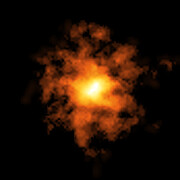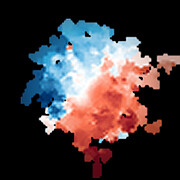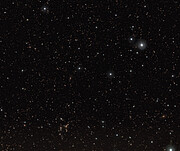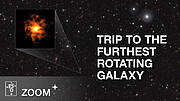Tisková zpráva
Vesmírná kuriozita: Nalezena nejvzdálenější galaxie s rotujícím diskem
7. října 2024
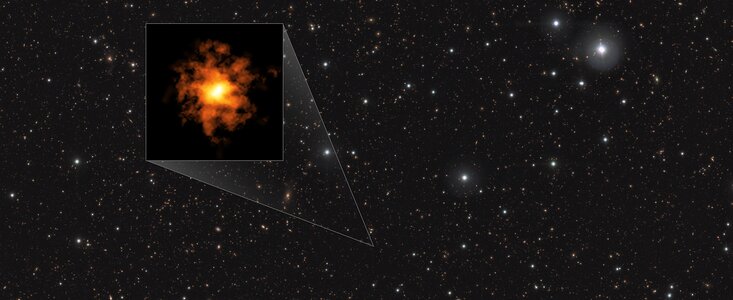
Vědci objevili dosud nejvzdálenější galaxii podobnou Mléčné dráze. Disková galaxie přezdívaná REBELS-25 ukrývá struktury jako současné galaxie, přitom se na ni díváme v podobě, kterou měla pouhých 700 milionů let po vzniku vesmíru. To je překvapivé, protože podle našich současných znalostí o vzniku galaxií jsou rané galaxie na pohled chaotičtější. Rotaci a strukturu galaxie REBELS-25 se podařilo odhalit pomocí soustavy ALMA (Atacama Large Millimeter/submillimeter Array), jejímž partnerem je Evropská jižní observatoř (ESO).
Galaxie, které vidíme dnes, urazily dlouhou cestu od svých chaotických, nesourodých protějšků, které astronomové obvykle pozorují v raném vesmíru. „Podle našeho chápání vzniku galaxií očekáváme, že většina raných galaxií bude malá a neuspořádaná,“ říká Jacqueline Hodge, astronomka z Leidenské univerzity v Nizozemsku a spoluautorka studie.
Tyto nesourodé rané galaxie se navzájem spojují a pak velmi pomalu získávají čím dál hladší podobu. Současné teorie naznačují, že aby galaxie byla tak uspořádaná jako naše Mléčná dráha - rotující disk s úhlednými strukturami, jako jsou spirální ramena - musely uplynout miliardy let vývoje. Objev galaxie REBELS-25 však tento časový rámec zpochybňuje.
Ve studii, která byla přijata k publikaci v časopise Monthly Notices of the Royal Astronomical Society, astronomové prokázali, že REBELS-25 je nejvzdálenější silně rotující diskovou galaxií, jaká kdy byla objevena. Světlo, které k nám z této galaxie přichází, bylo vyzářeno v době, kdy byl vesmír starý pouhých 700 milionů let, což je jen pět procent jeho současného stáří (13,8 miliardy), proto je uspořádaná rotace galaxie REBELS-25 takovým překvapením. „Vidět galaxii, podobnou naší Mléčné dráze, která má silnou rotační dominanci, zpochybňuje naše chápání toho, jak rychle se galaxie v raném vesmíru vyvíjely v uspořádané galaxie dnešního vesmíru,“ říká Lucie Rowland, doktorandka na Leidenské univerzitě a první autorka studie.
Galaxie REBELS-25 byla původně objevena při dřívějších pozorováních téhož týmu, také pomocí radioteleskopu ALMA, který se nachází v chilské poušti Atacama. Skupina už tehdy rozpoznala náznaky rotace, ale rozlišení dat nebylo dostatečně vysoké, aby mohla s jistotou objev potvrdit. Provedla proto navazující pozorování s vyšším rozlišením, která potvrdila, že jde skutečně o galaxii lámající rekordy. „ALMA je jediným současným teleskopem s dostatečnou citlivostí a rozlišením, který umožňuje dosáhnout takového výsledku,“ říká Renske Smit, výzkumník z Liverpool John Moores University ve Velké Británii a rovněž spoluautor studie.
V datech se ale skrývají náznaky i dalších rozvinutých struktur podobných těm v Mléčné dráze, jako je středová protáhlá příčka, a dokonce i spirální ramena, i když k jejich potvrzení bude zapotřebí dalších pozorování. „Nalezení dalších důkazů o vyvinutějších strukturách by bylo úžasným objevem, protože by se jednalo o nejvzdálenější galaxii s takovými strukturami, která byla dosud pozorována,“ říká Rowland.
Budoucí pozorování galaxie REBELS-25 spolu s dalšími objevy raných rotujících galaxií mohou změnit naše chápání raného vzniku galaxií a vývoje vesmíru jako takového.
Další informace
Tento výzkum je prezentován v článku s názvem „ REBELS-25: Discovery of a dynamically cold disc galaxy at z=7.31“, který vyjde v Monthly Notices of the Royal Astronomical Society.
Pozorování byla provedena v rámci Velkého programu ALMA REBELS: Reionization Era Bright Emission Lines Survey.
Skupinu tvoří L. E. Rowland (Leiden Observatory, Leiden University, the Netherlands [Leiden]), J. Hodge (Leiden), R. Bouwens (Leiden), P. M. Piña (Leiden), A. Hygate (Leiden), H. Algera (Astrophysical Science Center, Hiroshima University, Japan [HASC]; National Astronomical Observatory of Japan, Japan), M. Aravena (Núcleo de Astronomía, Facultad de Ingeniería y Ciencias, Universidad Diego Portales, Chile), R. Bowler (Jodrell Bank Centre for Astrophysics, University of Manchester, UK), E. da Cunha (International Centre for Radio Astronomy Research, University of Western Australia, Australia; ARC Centre of Excellence for All Sky Astrophysics in 3 Dimensions), P. Dayal (Kapteyn Astronomical Institute, University of Groningen, the Netherlands), A. Ferrara (Scuola Normale Superiore, Italy [SNS]), T. Herard-Demanche (Leiden), H. Inami (HASC), I. van Leeuwen (Leiden), I. de Looze (Sterrenkundig Observatorium, Ghent University, Belgium), P. Oesch (Department of Astronomy, University of Geneva, Switzerland; Cosmic Dawn Center, Denmark), A. Pallottini (SNS), S. Phillips (Astrophysics Research Institute, Liverpool John Moores University, UK [LJMU]), M. Rybak (Faculty of Electrical Engineering, Delft University of Technology, the Netherlands; Leiden; Netherlands Institute for Space Research, the Netherlands), S. Schouws (Leiden), R. Smit (LJMU), L. Sommovigo (Center for Computational Astrophysics, Flatiron Institute, USA), M. Stefanon (Departament d’Astronomia i Astrofísica, Universitat de València, Spain; Grupo de Astrofísica Extragaláctica y Cosmología, Universitat de València, Spain), P. van der Werf (Leiden).
ALMA (Atacama Large Millimeter/submillimeter Array) je mezinárodní astronomické zařízení, jenž společně provozují ESO, U.S. National Science Foundation (NSF) a National Institutes of Natural Sciences (NINS) of Japan ve spolupráci s Chile. ALMA je financována ESO jménem jejích členských států, NSF ve spolupráci s National Research Council of Canada (NRC) a National Science and Technology Council (NSTC) na Tchaj-wanu a NINS ve spolupráci s Academia Sinica (AS) na Tchaj-wanu a Korea Astronomy and Space Science Institute (KASI). Výstavbu a provoz soustavy ALMA vede ESO jménem svých členských států, National Radio Astronomy Observatory (NRAO) řízená Associated Universities, Inc. (AUI) za severní Ameriku a National Astronomical Observatory of Japan (NAOJ) za východní Asii. The Joint ALMA Observatory (JAO) poskytuje jednotné vedení a management výstavby, plánování a provozu soustavy ALMA.
Evropská jižní observatoř (ESO) umožňuje vědcům z celého světa objevovat tajemství vesmíru ve prospěch všech. Navrhujeme, stavíme a provozujeme pozemní observatoře světové úrovně, které astronomové využívají k řešení vzrušujících záhad vesmíru a šíření fascinace astronomií, a podporujeme mezinárodní spolupráci v oblasti astronomie. ESO bylo založeno jako nadnárodní organizace v roce 1962 a dnes ji podporuje 16 členských států (Belgie, Česká republika, Dánsko, Francie, Finsko, Irsko, Itálie, Německo, Nizozemsko, Polsko, Portugalsko, Rakousko, Spojené království, Španělsko, Švédsko a Švýcarsko), hostitelský stát Chile a Austrálie jako strategický partner. Sídlo ESO a její návštěvnické centrum a planetárium ESO Supernova se nachází nedaleko německého Mnichova, zatímco chilská poušť Atacama, nádherné místo s jedinečnými podmínkami pro pozorování oblohy, je domovem našich dalekohledů. ESO provozuje tři pozorovací stanoviště: La Silla, Paranal a Chajnantor. Na Paranalu provozuje Very Large Telescope a jeho Interferometr, jakož i přehlídkové dalekohledy, jako je VISTA. Na Paranalu bude ESO také hostit a provozovat soustavu Čerenkovových teleskopů (Cherenkov Telescope Array South), největší a nejcitlivější observatoř pro gama záření na světě. ESO společně s mezinárodními partnery provozuje na Chajnantoru observatoř ALMA, která pozoruje oblohu v milimetrovém a submilimetrovém pásmu. Na Cerro Armazones poblíž Paranalu budujeme "největší oko upřené k nebi" - Extremely Large Telescope. Z našich kanceláří v Santiagu v Chile podporujeme naší činnost v zemi a spolupracujeme s chilskými partnery a společností.
Odkazy
Pro novináře: přihlašte se k odběru tiskových zpráv v češtině
Pro vědce: máte pro nás námět? Popularizujte svůj výzkum
Kontakty
Lucie Rowland
Leiden Observatory, University of Leiden
Leiden, The Netherlands
Tel.: +31 71 527 2727
Email: lrowland@strw.leidenuniv.nl
Jacqueline Hodge
Leiden Observatory, University of Leiden
Leiden, The Netherlands
Tel.: +31 71 527 8450
Email: hodge@strw.leidenuniv.nl
Renske Smit
Astrophysics Research Institute, Liverpool John Moores University
Liverpool, UK
Tel.: +44-151-231-2922
Email: R.Smit@ljmu.ac.uk
Bárbara Ferreira
ESO Media Manager
Garching bei München, Germany
Tel.: +49 89 3200 6670
Mobil: +49 151 241 664 00
Email: press@eso.org
Anežka Srbljanović (press contact Česko)
ESO Science Outreach Network
a Astronomical Institute of Czech Academy of Sciences
Tel.: +420 323 620 116
Email: eson-czech@eso.org
O zprávě
| Tiskové zpráva č.: | eso2415cs |
| Jméno: | REBELS-25 |
| Typ: | Early Universe : Galaxy |
| Facility: | Atacama Large Millimeter/submillimeter Array |
| Science data: | 2024MNRAS.535.2068R |
Our use of Cookies
We use cookies that are essential for accessing our websites and using our services. We also use cookies to analyse, measure and improve our websites’ performance, to enable content sharing via social media and to display media content hosted on third-party platforms.
ESO Cookies Policy
The European Organisation for Astronomical Research in the Southern Hemisphere (ESO) is the pre-eminent intergovernmental science and technology organisation in astronomy. It carries out an ambitious programme focused on the design, construction and operation of powerful ground-based observing facilities for astronomy.
This Cookies Policy is intended to provide clarity by outlining the cookies used on the ESO public websites, their functions, the options you have for controlling them, and the ways you can contact us for additional details.
What are cookies?
Cookies are small pieces of data stored on your device by websites you visit. They serve various purposes, such as remembering login credentials and preferences and enhance your browsing experience.
Categories of cookies we use
Essential cookies (always active): These cookies are strictly necessary for the proper functioning of our website. Without these cookies, the website cannot operate correctly, and certain services, such as logging in or accessing secure areas, may not be available; because they are essential for the website’s operation, they cannot be disabled.
Functional Cookies: These cookies enhance your browsing experience by enabling additional features and personalization, such as remembering your preferences and settings. While not strictly necessary for the website to function, they improve usability and convenience; these cookies are only placed if you provide your consent.
Analytics cookies: These cookies collect information about how visitors interact with our website, such as which pages are visited most often and how users navigate the site. This data helps us improve website performance, optimize content, and enhance the user experience; these cookies are only placed if you provide your consent. We use the following analytics cookies.
Matomo Cookies:
This website uses Matomo (formerly Piwik), an open source software which enables the statistical analysis of website visits. Matomo uses cookies (text files) which are saved on your computer and which allow us to analyze how you use our website. The website user information generated by the cookies will only be saved on the servers of our IT Department. We use this information to analyze www.eso.org visits and to prepare reports on website activities. These data will not be disclosed to third parties.
On behalf of ESO, Matomo will use this information for the purpose of evaluating your use of the website, compiling reports on website activity and providing other services relating to website activity and internet usage.
Matomo cookies settings:
Additional Third-party cookies on ESO websites: some of our pages display content from external providers, e.g. YouTube.
Such third-party services are outside of ESO control and may, at any time, change their terms of service, use of cookies, etc.
YouTube: Some videos on the ESO website are embedded from ESO’s official YouTube channel. We have enabled YouTube’s privacy-enhanced mode, meaning that no cookies are set unless the user actively clicks on the video to play it. Additionally, in this mode, YouTube does not store any personally identifiable cookie data for embedded video playbacks. For more details, please refer to YouTube’s embedding videos information page.
Cookies can also be classified based on the following elements.
Regarding the domain, there are:
- First-party cookies, set by the website you are currently visiting. They are stored by the same domain that you are browsing and are used to enhance your experience on that site;
- Third-party cookies, set by a domain other than the one you are currently visiting.
As for their duration, cookies can be:
- Browser-session cookies, which are deleted when the user closes the browser;
- Stored cookies, which stay on the user's device for a predetermined period of time.
How to manage cookies
Cookie settings: You can modify your cookie choices for the ESO webpages at any time by clicking on the link Cookie settings at the bottom of any page.
In your browser: If you wish to delete cookies or instruct your browser to delete or block cookies by default, please visit the help pages of your browser:
Please be aware that if you delete or decline cookies, certain functionalities of our website may be not be available and your browsing experience may be affected.
You can set most browsers to prevent any cookies being placed on your device, but you may then have to manually adjust some preferences every time you visit a site/page. And some services and functionalities may not work properly at all (e.g. profile logging-in, shop check out).
Updates to the ESO Cookies Policy
The ESO Cookies Policy may be subject to future updates, which will be made available on this page.
Additional information
For any queries related to cookies, please contact: pdprATesoDOTorg.
As ESO public webpages are managed by our Department of Communication, your questions will be dealt with the support of the said Department.


